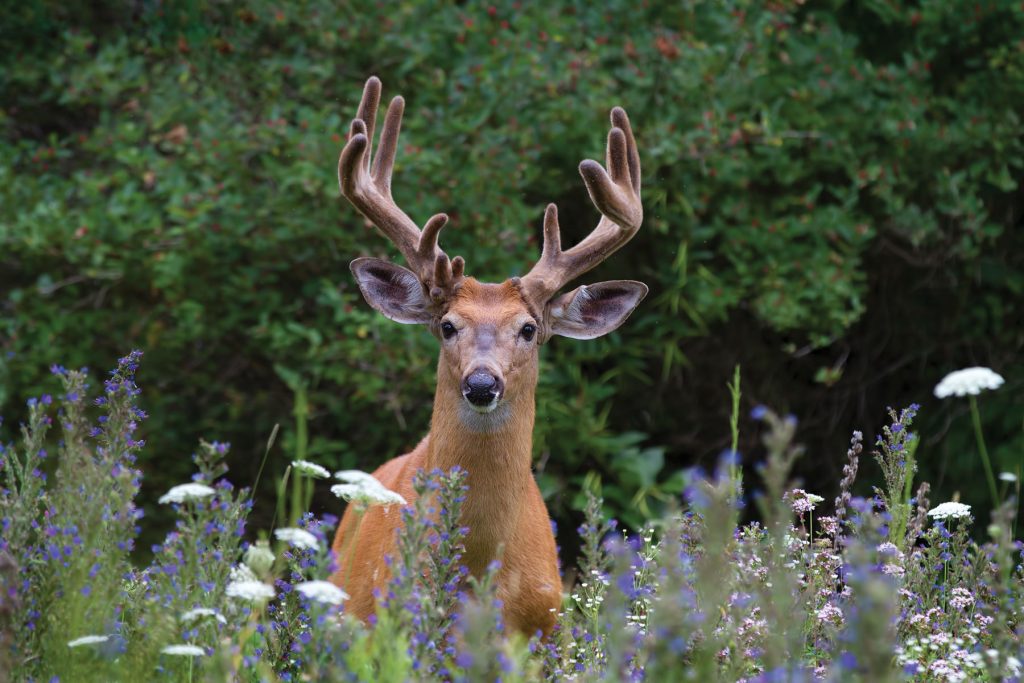Oh My Deer!

By Andrew Spencer
If we learned anything at all from the Jurassic Park franchise, it’s that sometimes interfering with nature can have some unintended consequences. Such was the case on Nantucket back in the 1920s, though it didn’t involve genetically engineered dinosaurs or rogue scientists. No, this little story of misguided benevolence involved some of the most meek and cutest animals to be found anywhere: deer.
According to the Nantucket Conservation Foundation and others who know these sorts of things, deer have been on Nantucket off-and-on since the beginning of its existence as an island. Archaeological remains dating as far back as 3,500 years ago indicate the presence of deer on Nantucket. That’s a nice story and all. However, what does it have to do with Jurassic Park? As my mother always said, hold your horses, kid. We’ll get there. In this case, though, it might be more appropriate to say hold your deer.
In the late 1800s, the local deer were hunted to extinction, according to reports. Then, one day in 1922, a fishing boat called the Antonia found a male deer swimming in Nantucket Sound between Nantucket and the Cape. The crew brought him aboard and, as the boat was bound for Nantucket, they took him there and released him in the woods adjacent to what is today Milestone Road.
I’m a writer by training, a professional reality that is due in no small part to the fact that I was a profoundly bad science student. Case in point, biology and I were distant acquaintances at best in high school, and I never really understood the value of learning the photosynthesis process. That said, I’m well-versed enough in the basics of biology to know that it takes two to make three, if you get my drift, and with just one lone buck carousing around the State Forest, it doesn’t stand to reason that his presence was enough to create a problem. Again, we’ll get there. You just need to be patient a little longer.

Buck with velvet antlers in a summer meadow amongst one of Nantucket’s most popular wild flower, Queen Annes’ lace 


A newborn less than one hour old
In 1926, a well-intentioned summer resident of Nantucket felt sorry for the poor fella living out there all by his lonesome, so he imported a pair of girlfriends for him. Once the does arrived on Nantucket, well, let’s just say that the result was what you might have expected from such a liaison that ended the old boy’s four-year drought. Today the Nantucket deer herd which, given that there are no natural predators on the island, has blossomed from that preliminary trio to a size of approximately 50 deer per square mile.
Unfortunately, the island’s ever-growing deer herd has fostered an ever-growing population of deer ticks, the primary carriers of Lyme disease. White-tailed deer get a little bit of a bad rap for their link to Lyme disease, because it’s actually the deer ticks that carry the bacteria, and those ticks pick up that bacteria from a particular species of mice. So where’s the deer connection? The mice in question are white-footed mice, also known as deer mice. The deer ticks pick up the bacteria from those mice, but then have a biological requirement to feed on the blood of deer. So by that logic, without the deer, the deer ticks wouldn’t be able to survive.
Lyme disease was named for the town of Old Lyme, Connecticut, where it was first recognized as an official disease in 1975. And while specific numbers are hard to come by, estimates put the number of Nantucketers who have had Lyme at 2,500, or a quarter of the island’s year-round population. That statistic has thrust the island into the national conversation regarding Lyme prevention, and has also thrust Dr. Tim Lepore, one of the island’s best-known physicians (not to mention a 48-time finisher of the Boston Marathon) into that same conversation. Over the years, Lepore has become one of the nation’s leading experts on Lyme disease.
Lyme is oftentimes – though not always – accompanied by a distinctive bullseye rash; the tick bite itself, no larger than a pinprick, is the center, with a red ring radiating out from that center. The disease also tends to cause joint pain, fatigue, fever and nausea. In other words, it feels like you have a case of the flu. “On Nantucket, there’s no such thing as a summer flu,” said Lepore. “So most often when people come in with flu-like symptoms, very frequently they have Lyme disease.”
It turns out that these nasty little bugs carry bacteria for more than just Lyme. There’s also babesiosis, anaplasmosis, and borrelia miyamotoi, all of which can have much more dangerous effects than Lyme, especially if left untreated.

White-tailed stag in a meadow outlined by the sunset 
White-tailed stag in the forest 


Antlers are shed annually and can be found throughout Nantucket
Now you’ve read about the potential horrors of tick-borne illnesses, who’s ready to go outside?
The thing about Lyme – and all of its relations – is that, though the sickness itself is miserable, it’s also fairly easy to avoid. “Prevention is the easiest – the cheapest – way to avoid Lyme,” said Dr. Lepore. Deer ticks like shady spots, especially in long grass or bushes, as well as dead and decaying plant matter. Stay on the marked paths or trails when out walking, and minimize your exposed skin. Wear light-colored clothes that will help you spot ticks before they bite you, including long pants and long sleeves, and tuck your pants legs into your socks. You’re probably not going to win a fashion award, but you’re also going to be a lot less likely to be bitten by a tick. Also, be sure to liberally apply insect repellent that contains DEET.
Once you get home from your outdoor adventure, check yourself and your kids thoroughly for ticks, and remember that a full-grown deer tick is often smaller than the head of a pin. So look very closely, and don’t forget your back. Taking your clothes off and putting them in the dryer on high heat for a few minutes will kill any hitchhikers that are still in your clothes.
Sometimes, no matter how careful you are and how many precautions you take, you’ll still find a tick on yourself. The first thing to do if you find a tick, is to relax. It takes more than twenty-four hours of being embedded in your skin for the deer tick to transmit the bacteria to you. “The most important thing is to get the tick off of you,” said Dr. Lepore.
Nantucket is a natural wonderland. The natural beauty that surrounds us is magical, and many of us – locals and visitors alike – tend to sometimes forget that we’re living in a place that has some hazards. However, the risks can be minimized if we just take a few easy precautions.
Article edited. Full version available in ONLY NANTUCKET FALL/WINTER 2017.

